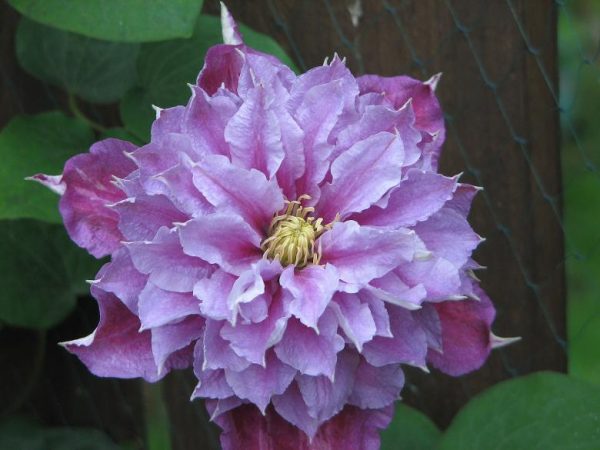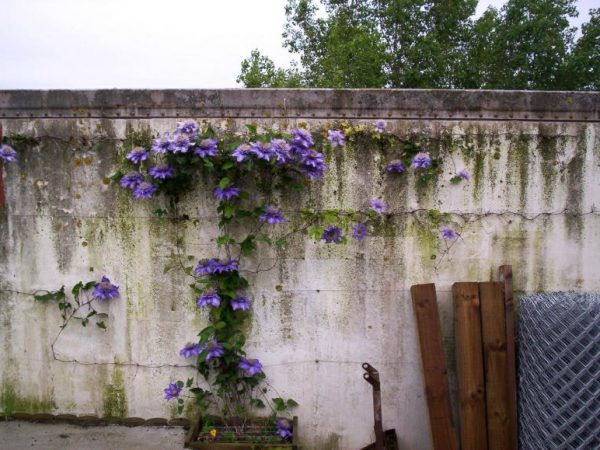Shelter clematis for the winter - rules and terms
Clematis are thermophilic plants. Shelter for the winter is a mandatory activity that is included in the pre-winter care. If you ignore the procedure, you can face freezing of the root system.

Shelter of clematis for the winter
Optimal timing
They begin to prepare clematis for winter after the foliage has completely wilted. The still-preserved green aboveground part serves as a source of supply to the root system of nutrition, which the plant needs before the cold season, so you should not rush to remove it.
They try to cover the garden culture at the onset of the first autumn frosts. The terms of insulation depend on regional characteristics:
- in northern areas this time falls on the end of September-beginning of October;
- in the central strip, you can hide flowers for the winter until mid-autumn;
- in the southern regions, from late October to the second half of November.
The main rule that should be followed is the final setting of the temperature around -2-5 ° C. All activities are carried out in dry weather without precipitation in order to prevent moisture from retaining inside the shelter.
If the procedure is carried out earlier, the plants under the covering material will begin to rot, creating favorable conditions for the development of decay processes and the appearance of a fungus.
Preparation rules
Before the shelter, the flower culture is prepared:
- cut off shoots;
- inspected for the presence of diseases and pests, treated with insecticides and fungicides;
- in order to prevent the occurrence of a fungus, they are treated with iron vitriol with a concentration of 2% or Bordeaux liquid with a fraction of the active substance of 1%;
- the soil around the bush is sprayed with Fundazol (20 g per 10 liters of water);
- the area of the trunk circle is cleared of debris and leaf litter;
- vines are untied from supporting structures, leaves are removed and folded on the ground, pressing the shoots.
Shelter technology
The pruning and features of the shelter are chosen depending on belonging to the group.

How to cover clematis for the winter
First trimming group
The first group contains varieties of clematis, in which the formation of buds takes place on last year's ligneous vines: Vititsella, Zhakmana, Integrifolia.
Such plants almost do not need pruning, but they require more thorough warming for the winter, which will not only protect against frost, but also prevent the accumulation of excess moisture and dampness.
The peculiarity of pre-winter preparation is the need to preserve almost the entire above-ground part of the bush.
Technology:
- after laying the vines, an air cushion is formed - they make a frame and cover it with a layer of coniferous spruce branches or branches from other ornamental shrubs;
- covering material (for example, spandbond, agrofibre, lutrasil) is laid out on top of the frame in 2-3 layers;
- organize additional insulation in the form of another air cushion, covering them with plywood sheets or boards.
Coniferous spruce branches serve as an auxiliary measure of protection against rodents, does not cake and contains phytoncides - biologically active substances that have a detrimental effect on the growth and development of bacteria and fungi.
Another option for wintering a garden plant is laying in sawdust or dry grass:
- plastic wrap is lined under the clematis;
- a layer of dry sawdust or dried vegetation is poured onto the polyethylene;
- lianas are laid out on natural insulation, fixed with staples;
- sprinkle on top with another layer of sawdust or grass;
- covered with non-woven covering material - spunbond, lutrasil, agrofiber;
- the edges are fastened with heavy objects, for example, bricks;
- at the top, over the entire area, they are built covering from plywood, boards or slate.
As a result of such storage in winter, plastic wrap prevents the plant from penetrating moisture from the ground, and the upper protection creates an obstacle for moisture to enter with precipitation.
1 trimming group
Second trimming group
In the second group, all vigorous representatives of clematis with alpine, large-cup forms. All varieties are re-flowering. On the first wave, their inflorescences bloom on last year's lignified shoots. In the subsequent flowering stage, buds are formed on seasonal young stems.

Clematis shelter for the winter
These subspecies are pruned in stages:
- in the spring - they carry out sanitary pruning;
- in the summer - remove the faded part;
- in the fall - the shoots formed during the season are shortened by 1 / 3-1 / 2, leaving up to 1 m in height.
These varieties also need warm shelter regardless of the growing region.
They are covered according to the technology for varieties of 1 type of pruning, without an additional insulating layer.
Third trimming group
Clematis of the third group are considered the most unpretentious and frost-resistant, capable of withstanding frosts down to -40 ° C. Includes varieties - Florida, Patens, Lanuginoza.
Flowers are formed only on the stems of the current year, which, when leaving in autumn, are heavily pruned, almost to the base, leaving only 2-4 lower nodes with 2-3 pairs of buds. When grown in warm climatic zones, they do not need to be covered, however, in regions with cold winters, there is a high risk of freezing of the root system.
Even when growing in unfavorable conditions, such varieties of clematis do not need a dense shelter. Usually, for these subspecies, cover with spruce branches or branches with mulching of the trunk circle is enough.
The best insulation is snow cover. Snow is regularly thrown in the form of a protective mound.
When and how to remove insulation
Garden flowers are opened at the final establishment of positive temperatures, when the snow cover has completely melted. This time depends on regional climatic characteristics and covers the period from early to late April. Previously, you should remove the polyethylene cover, which does not allow air and moisture to pass through, having previously cleaned the protection from snow.
The first event after removing the insulation is to unroll the bushes.
The covering layer is not removed completely immediately, but gradually, in order to give the plant time to adapt and enter into active vegetation at the end of the dormant state.
After the adaptation period, spring formative pruning is carried out, removing poorly developed and affected shoots.
Useful tips from gardeners
Some helpful tips will help protect clematis from freezing in winter and unnecessary dampness.

Do I need to cover clematis for the winter
- In areas with severe and snowless winters, the bases of the bushes are additionally piled up, protecting the root collar with a layer of dry compost, garden soil, a mixture of coarse river sand with wood ash, humus or peat 30-40 cm thick.This insulation will help preserve several buds, which in spring will give growth to new shoots, even if the entire upper part is frozen.
- It is necessary with due care to follow the recommendations to press in the form of a ring of clematis related to 1 and 2 subspecies of pruning. This arrangement makes it easier to cover the plant, but the fragile stems often break.
- The creation of an air cushion is a prerequisite for the wintering of this garden culture, which suffers more from damping out than from freezing.
- Boards, slate, plywood folded over the entire area of the covering material will become moisture-proof protection and prevent dampness.
- In order to avoid freezing of the bush due to spring return frosts, it is recommended not to remove the polyethylene at once, but to make several holes in it, which can be covered with the onset of low temperatures.
- You should not uproot that clematis, which at first glance is frozen, and its roots have not been preserved. You can try to restore it, providing the remains of the plant that have survived in the soil with normal care and mandatory covering for the winter. Sometimes it takes 2-3 years to fully recover.
- When choosing polyethylene as a covering material, which does not allow air to pass through, it is necessary to make air vents from 2-4 sides in order to supply oxygen.

